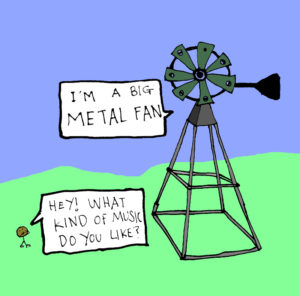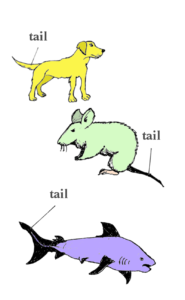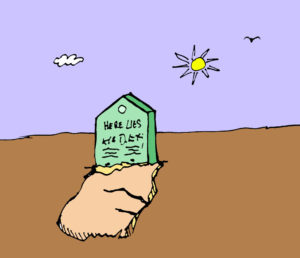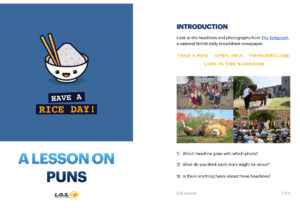What are puns and why am I reading about them?
Well, let me start off by telling you that I’m a massive fan of puns.
Puns are often known as “dad jokes.”
That’s because you hear a lot of very bad puns from middle-aged men who think that being unfunny is being funny … if you know what I mean.
But that’s the beauty of puns – the worse they are, the better they are.
But what are they?
I think the best way to explain what a pun is is by showing you. So here are some examples:
“What happened to your head?”
“Oh, I got hit by a book.”
“Oh well – I guess you only have your shelf to blame.”
See what happened there?
No? OK – how about this one:

You got it, right?
Puns are jokes that work because of different words that sound the same but have different meanings.
“You only have yourself to blame,” vs. “You only have your shelf to blame.”
Or jokes that work because one word has two meanings (otherwise known as homonyms, homophones and heteronyms):
“I’m a big metal fan” – someone who loves metal music vs. a big ventilator made out of metal.
My life is filled with puns, and I find myself even accidentally making them all the time.
Here are some typical conversations in my house:
My partner: Oh no, we’re out of beans. No beans and rice for dinner …
Me: Shame. That would’ve been good.
My partner: Are you taking anything to drink to the party?
Me: I was thinking of bringing some Merlot, but it’s a bit hot for wine, so I might just go for beer.
My partner: Why not? (This sounds like “wine not,” which is precisely what I’m bringing: not wine.)
But why should you learn puns?
Well – there are a few reasons.
First of all, they’re a great way to think about the language in a playful way. You also get a stronger vocabulary, and you even get to develop a new part of your English-speaking identity: the funny person.
Puns are actually pretty common. You’ll find them in literature, on TV and – most commonly of all – in newspapers.
That’s right, tabloid newspapers (the cheaper, more sporty kind of newspaper) LOOOOOOVE puns. And without understanding how puns work, you won’t be able to understand 90 percent of the UK and US tabloid headlines.
So let’s take a look at some great examples of puns in the tabloids and great puns in literature. This will give us a nice range of low-brow puns (the “people’s puns”) and high-brow ones (smarter and more intellectual).
Puns in tabloid headlines
Some puns play on famous song lyrics.
Remember Bohemian Rhapsody (the song – not the film) …
… and the opening lines, “Is this the real life? Is this just fantasy? Caught in a landslide. No escape from reality”?
Well, a newspaper reporting on the privatisation of the rail industry decided to go for this headline:
Is this the rail price? Is this just fantasy? Caught up in land buys. No escape from bureaucracy.
Another one, featured in The Times, reported on the leader of the Labour party, Michael Foot, becoming the head of a government body (organisation) that aimed to disarm the country’s nuclear weapons.
Look at that sentence one more time. Did you notice a lot of body parts in there? Arm. Foot. Body. Head.
Well, so did the Times, who went for the headline:
Foot Heads Arms Body
Let me just break that down.
Foot (Michael Foot) Heads (leads) Arms Body (an organisation about weapons).
Good? OK – onwards!
Finally, one from across the pond. (That’s a British expression meaning the US.)
A human body was found in a bar in New York back in the early ’80s.
The body was missing a head.
And the bar was one of those bars where sad men go to watch women dancing without their shirts on – a strip bar, basically, otherwise known as a topless bar.
So what headline did the New York Post go for?
Headless Body In Topless Bar
Puns in English literature
If you’re into reading literature and books, especially if you tend towards the classics, then you’ll find it useful to know how puns work.
In Alice in Wonderland, the writer Lewis Carroll plays on the homophone “tail” / “tale.”
A tail is the long bit of a mammal that goes out behind its body – think of a happy dog wagging its tail or an irritated cat moving its tail around.

A tale is just another word for story.
Here’s how Alice in Wonderland plays with this homophone:
“Mine is a long and a sad tale!” said the Mouse, turning to Alice, and sighing. “It is a long tail, certainly,” said Alice, looking down with wonder at the Mouse’s tail; “but why do you call it sad?”
Shakespeare was also a big fan of puns.
In Romeo and Juliet, Mercutio, one of Romeo’s best friends, gets fatally stabbed.
He’s such a funny guy, so can’t help making a joke, even as he’s clearly about to die. Because Shakespeare.
In this case, he plays on the homonym “grave.”
A grave is where you’re buried after you die.
You know … one of these:

And it also means “serious.”
So what does Mercutio say?
… ask for me tomorrow, and you shall find me a grave man.
Finally, Groucho Marx, a 20th-century comedian, created an awesome double pun, playing with the double meaning of “flies” and the double meaning of “like.”
Flies can be the second person verb form of “fly,” as in “time flies.”
It can also be the plural of “fly,” the small insect that looks like this:

You get different kinds of flies, including fruit flies. This is important, and you’ll see why later.
But first, let’s look at the word “like.”
“Like” can be a verb, as in “He likes metal music.”
Or it can be a preposition, as in “He lives like a king.”
OK … so we’ve got the homonyms “flies” and “like.”
So here we go – ready for the Marx quote?
I’ll be honest, this one took a while for me to understand, so spend some time with it if you don’t get it at first – it’s worth the wait!
Time flies like an arrow. Fruit flies like a banana.
And there we have it – the strange world of puns.
So now, over to you.
Think of some words that sound, or even look, the same in English. You know, like “like” or “flies” or “body” or “head” or “fan” or … well, there are lots here:
Can you make a pun out of them?
Gabriel Clark, LOS Consultant & Clark and Miller Co-founder

